Black History Timeline: 1600s to Present Day


Black history in the United States of America is a story of discrimination, hate, and violence. For centuries, White people enslaved, murdered, and criminalized an entire race on the basis of their skin color. Undoubtedly, remembering this is crucially important for ensuring we never forget how modern-day’s society has been built upon a history of injustice.
However, Black history in America is also defined by examples of perseverance, struggle, and determination to defy violent oppression and fight for fair and equal rights. Alongside the persecution, individuals and groups stood up in the face of hatred to demonstrate the excellence of Black cultures and societies.
Today, things still aren’t perfect and the legacy of a two-tier society remains in the social positions of different ethnicities, but more people are standing up in unison to call out the bad and build a more tolerant society.
Why is Black History Important?
Black history arguably goes back to the beginning of humanity if you go by skin color alone. Scientific evidence suggests that early homo sapiens likely had dark skin and almost certainly evolved in Africa, now the continent most closely associated with traditional Black countries and societies.
To only ever document the relatively small portion of history from 1600 in a single location would be a disservice to Black cultures, let only entirely unrepresentative of entire ethnicities.
Therefore, it is important to remember whilst reading this timeline, that Black people are not defined only by this specific period in time. Nonetheless, remembering Black history in the USA during this time period is still incredibly important. First of all, documenting the levels of discrimination and violence that Black people experience is crucial to understanding why society remains unequal today.
For example, we must always know that White ethnicities are, generally speaking, more likely to hold higher-ranking job positions or earn more money because of historically informed structural and institutionalized racism. It is also important as a way of holding those who perpetrated injustices to account and ensuring that we never slip anywhere close to what happened again.
In another way, it is important to document Black history to highlight those that struggled against oppression to fight for a future where Black people could live equally to everyone else.
If we only speak about the violence and oppression, then we lose sight of key figures in Black history that have both defined, and continue to define, where Black societies stand today.
Timeline of Black History
The timeline of Black history in the USA is long, beginning with outright oppression and developing through early Black rights, segregation, the civil rights movement, and eventually a society where Black cultures have emerged as dominant forces in modern-day life.
Key figures throughout the timeline include politicians like Abraham Lincoln, activists like Rosa Parks and Martin Luther King, and societies such as the NAACP. In the background of it all, major events played out in society such as American independence from the British, the American Civil War, and both World Wars.
When Did Black History Begin and Where?
In general, Black history, in terms of skin color alone, began in the continent of Africa about 60,000 years ago. The earliest humans are thought to have had dark skin as a means of protecting their bodies from intensive sunlight. In fact, it is believed that all Homo sapiens are descended from common ancestors who originated in Africa.
Modern African Americans are descended from ancestors in West and Central Africa that were transported as slaves to the USA and other western countries. In that sense, the history of modern-day Black Americans is firmly rooted in African societies that have now developed into sovereign countries.
Modern Black history, when things like modern Black music, art, literature, and a general distinctive culture came about, was a result of an amalgamation between African heritage and the cultural features of the countries their ancestors were transported to.
What are 4 Major Movements of African American History?
While the whole of Black history is important and impactful, certain movements stand out as particularly fascinating and progressive, helping society arrive at the point of acceptance that it has today.
Abolitionist Movement
Contrary to popular belief, the abolitionist movement began well before the input of Abraham Lincoln in the 1800s. As early as 1688, German Quakers living in colonial America issued their own petition to end slavery.
It was then carried forward from then by evangelical colonists who saw slavery as an affront to the humanitarian dynamics of Christianity. During the Revolutionary War against the UK, all existing states outlawed international slave trading, and northern states of the Union abolished slavery entirely during the intervening years between the Civil War.
Southern states refused to do the same and the Civil War evolved to largely become concerned with the ending of slavery, with the Republican north led by Lincoln. The Emancipation Proclamation was announced in 1863 upon the end of the civil war, abolishing slavery across the entirety of the USA.
Underground Railroad
Around the same time as Lincoln came to prominence, the Underground Railroad was formed. The Railroad wasn’t a highly organized, country-level organization but rather many individual small groups of abolitionist sympathizers that would work to free slaves in the south and transport them to the north.
The process would involve identifying a slave in the south and then sending someone to pick them up once they had escaped. The free person would then be relayed across the country by a series of helpers until they reached their final destination. Often, this was Canada where they would be less at risk of being kidnapped and re-enslaved, but for some states such as Louisiana, a southern route to Mexico was easier.
Civil Rights Movement
The Civil Rights movement started in 1954 when protests and action against structural racism in the USA became a widely adopted strategy to fight for Black rights. After the Civil War, Black people were made free from enslavement and given some equal rights. However, as time progressed, racist sentiments remained and began influencing social attitudes against non-White people.
Segregation became the norm and the Jim Crow laws were adopted wholeheartedly in the southern states. Key figures came to prominence in this era, such as Rosa Parks and Martin Luther King, as focal points for the fight for true racial equality. This ended in 1968 with the passing of various civil rights acts which outlawed things like segregation in schools. However, struggles against racism remained after this time and still exist today.
Black Lives Matter
The Black Lives Matter movement began in 2013 after Trayvon Martin, a Black teenager, was killed by George Zimmerman, a white male. Zimmerman was acquitted of all charges which caused uproar in Black communities and beyond at what was perceived as an unacceptable response to a racially motivated killing.
The movement took off on social media and was used as a way to bring attention to the everyday struggles Black Americans go through in life. It swelled into protests over further court rulings surrounding White people killing Black people and eventually became an official organization. It has been compared to the Civil Rights movement for its motivations and tactics.
What Are Some Important Moments in Black History?
Perhaps the most important moment in Black history was the first importation of slaves to the North American continent in 1619. This marked the beginning of mass slavery of African people and therefore determined the social position and struggles Black people would face for centuries to come.
Following this, the American Civil War put the issue of slavery front and center as the North fought the South in a conflict that became defined by this issue. The victor would have the chance to decide the future of slavery for the whole country and the victory of the abolitionist North proved key for Black freedoms. Nationwide emancipation soon followed which saw the transformation overnight for many Black people from slavery to freedom.
This didn’t mean that problems with racism were over. After decades of building hatred and institutionalized racism in America, the Civil Rights Movement kicked off as one of the key moments in Black history. Many place the starting point in 1955 when Rosa Parks refused to move from the "white’s only" section on a bus.
Another key moment within this period was the rise of Martin Luther King who became a figurehead and driving force for Black rights in 1963. Although he was assassinated in 1968, his legacy and motivations live on. The passing of the 1964 Civil Rights Act is also extremely important as the moment when discrimination in any form became officially illegal in the USA.
Struggles against racism continued throughout the 20th Century and into the 21st, especially with the legal system and policing. Barack Obama’s rise to the presidency in 2009 marked the first African American president and was symbolic of not only how far Black rights had come, but also how public attitudes had changed toward Black people. Most recently, the sparking of Black Lives Matter in 2013 represented a modern-day incarnation of the Civil Rights Movement and pushed the struggle of being Black in a prejudiced society into the spotlight.
Black History Moments: 1600s to Present Day
Below is a timeline of the key events that occurred in America from the first slaves arriving in the 1600s. It proceeds through early Black famous figures and emancipation attempts, to the American Civil War, the Jim Crow era, the Civil Rights Movement, and into modern-day histories.
| 1619 |
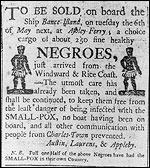 Photograph of newspaper
August The first African slaves, around 20-30, arrived in Jamestown, Virginia. The slaves were taken as a prize from a defeated Portuguese warship by the British Empire and transported via Mexico to the USA. The USA was still under colonial rule at this point and Britain was one of the largest slave traders in the world. African slaves had been brought to the U.S. mainland in the 1500s, but this was done so by the Spanish and they were part of a group of other slaves of other ethnicities. These colonies failed and are not considered a part of the organized slave trade that came about in 1619. |
| 1640 |
July John Punch, a Black male in indentured servitude, escapes from Virginia. He is later caught and sentenced to a life of service to his owner making him the first legally documented slave in America. After DNA testing, Punch was found to be a 12th-generation grandfather to President Barack Obama. He is also the ancestor of Ralph Bunche, the first African American to win the Nobel Peace Prize. |
| 1662 |
December The state of Virginia passes the principle of "partus sequitur ventrem" which states that children would take on their mother’s status upon birth. Therefore, a baby born to an enslaved mother would automatically become a slave. This is important because it turned Black people from being single-generation slaves to now multi-generational slaves. Usually, children took on their father’s status but this ruling meant that even if a white man fathered a Black woman’s child, the child would remain a slave. |
| 1670 |
Zipporah Potter Atkins becomes the first Black woman to own land in Boston, part of the soon-to-be United States of America. Anthony Johnson was one of the other first Black people to own property and gain significant wealth. He earned his freedom from servitude and was granted land in Virginia from which he farmed tobacco. Zipporah’s wealth came from an inheritance bestowed by her father. |
| 1705 |
October The Virginia Slaves Codes are introduced to consolidate the practice of slavery and the status of slaves in the state. The act allowed for the free trading of slaves with protections given by the courts, prohibited white people from being employed by Black people, and permitted runaways to be legally caught. Generally, the act gave a much greater legal basis for the control of Black people by white people in America. |
| 1738 |
Fort Mose in Spanish Florida became the first settlement in North America to be legally sanctioned as a free city for Black people. It was owned by Spanish colonists and run by a Mandinga General who gave refuge to runaway Black slaves who had escaped from British colonies. It is thought that Fort Mose represents a precursor to the Underground Railroad, if not literally then at least for its philosophy. |
| 1739 |
South Carolina slaves organized the Stono Rebellion on the Stono river. A literate slave named Jemmy led a group of 81 fellow slaves in an armed revolt against slave owners in southern states. They burned multiple plantations and killed around 40 white soldiers and slaves. The group was mostly killed by a local militia and their heads were mounted on spikes as a warning to other slaves. It was one of the largest, earliest slave rebellions in America. Another example is the New York City Slave Revolt in 1712. |
| 1746 |
August 25 Lucy Terry, an enslaved person in 1746, becomes the earliest known Black American poet when she writes about the last Native American attack on her village of Deerfield, Massachusetts. Her poem, "Bar's Fight", is preserved orally but not published until 1855. It is the oldest known poem by a Black person in America and the only work remaining from Terry. Terry was a slave, captured in Africa but freed by purchase by her future husband. |
| 1773 |
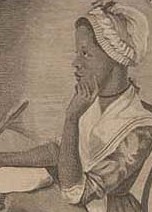 An illustration of Wheatley
Phillis Wheatley's book "Poems on Various Subjects, Religious and Moral" is published, making her the first African American to do so. Wheatley was kidnapped and sold into slavery to the Wheatley family. There she learned to read and write and was encouraged to pursue literature by her owners. Wheatley was emancipated following her book being published but died in poverty and obscurity. |
| 1775 |
April 14 The "Society for the Relief of Free Negroes Unlawfully Held in Bondage" is formed in Pennsylvania. Made up of mainly Quakers who opposed slavery on moral grounds, the group met four times and was reformed in 1784 as the Pennsylvania Abolition Society. In 1785, Benjamin Franklin served as president of the society which greatly influenced his petitioning of Congress to abolish slavery in 1790. This society still exists today. April 19 The American Revolutionary War begins against the British Empire. The British Empire offers freedom to any slave who fights for their cause, leading to around one-third of all enslaved people in the southern states fleeing to British-held states. After the war ended, most of the freed slaves were evacuated to Britain as free people along with other troops. Some left for Jamaica whilst others were granted land in Canada. |
| 1780 |
March 1 Pennsylvania becomes the first state to abolish slavery. In 1777, the Vermont Republic abolished slavery but they were not an integrated state at the time. A few years later in 1787, slavery was made illegal in territories north of the Ohio River and east of the Mississippi River. However, the U.S. Constitution states that Congress may not ban the slave trade until 1808. |
| 1787 |
July 13 Slavery is made illegal in the Northwest Territory through the Northwest Ordinance Act. |
| 1793 |
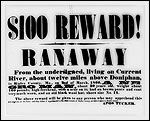 Poster advertising $100 reward
February 12 The Fugitive Slave Act is enacted, providing for the return of slaves who had escaped and crossed state lines. This greatly altered the prospects of slaves wishing to escape and effectively criminalized future organizations such as the Underground Railroad. This is key because slaves were now subject to the law both in and outside of bondage, no matter their situation.
|
| 1794 |
March 14 Eli Whitney's invention of the cotton gin greatly increases the demand for slave labor. Cotton gin greatly increases the productivity of farming cotton which, in turn, saw raised demand for cotton from the textile industry. Southern states saw the opportunity and it translated into an uptick in the desire for slave labor to maximize profits. This led to a forced migration of slaves to the southern states and started the Antebellum Period. The economy of the south became almost entirely structured around slave labor. |
| 1800 |
August 30 Gabriel Prosser, an enslaved African-American blacksmith, organizes a slave revolt intending to march on Richmond, Virginia. The conspiracy is uncovered, and Prosser and a number of the rebels — including Prosser — are hanged. Virginia's slave laws are consequently tightened. This specific rebellion is seen as important as it juxtaposed the professed ideals of freedom held by the Founding Fathers, with the blatant moral trespasses of slavery. |
| 1808 |
January 1 Congress makes the importation of slaves from abroad a felony, building on the previous year’s Act Prohibiting Importation of Slaves. There had been a demand for such acts to be brought much earlier, but the constitution prevented any lawmaking in this area from happening any earlier. January 1st, 1808, was the earliest Congress could introduce something that directly influenced the slave trade. |
| 1820 |
March 3 The Missouri Compromise bans slavery north of the southern boundary of Missouri. The Compromise was an attempt to reconcile the desires of the northern states to legally restrict the expansion of slavery, with the southern states who wanted to expand it. The symbolic nature of the figurative line drawn between the northern and southern states was not lost on America. In fact, the split between the two in the upcoming Civil War occur mostly along the line drawn in this legislation. |
| 1822 |
January 7 The American Colonization Society, founded by Presbyterian minister Robert Finley, establishes the colony of Monrovia (which would eventually become the country of Liberia) in western Africa. The society contends that the immigration of Black people to Africa is an answer to the problem of slavery as well as to what it feels is the incompatibility of the races. Over the course of the next 40 years, about 12,000 slaves are voluntarily relocated. July 2 Denmark Vesey, an enslaved African-American carpenter who had purchased his freedom, plans a slave revolt with the intent to lay siege on Charleston, South Carolina. The plot is discovered, and Vesey and 34 coconspirators are hanged. |
| 1831 |
January 1 William Lloyd Garrison begins publishing "The Liberator", a weekly paper that advocates the complete abolition of slavery. He becomes one of the most famous figures in the abolitionist movement and the paper helps spread the thinking to new audiences. He is a prominent preacher of Christianity and declares that slavery is one of the most heinous sins man can partake in. August 23 Nat Turner, an enslaved African-American preacher, leads the most significant slave uprising in American history. He and his band of followers launch a short, bloody, rebellion in Southampton County, Virginia. The militia quells the rebellion, and Turner is eventually hanged. As a consequence, Virginia institutes much stricter slave laws. The rebellion causes fear in the local population and local revenge killings of slaves top 120. |
| 1839 |
July 2 53 African slaves on board the slave ship, the Amistad, revolted against their captors, killing all but the ship's navigator, who sailed them to Long Island, instead of their intended destination, Africa. Joseph Cinqué was the group's leader. The slaves aboard the ship became unwitting symbols for the antislavery movement in the pre-Civil War United States. After several trials in which local and federal courts argued that the slaves were taken as kidnap victims rather than merchandise, the slaves were acquitted. The former slaves aboard the Spanish vessel Amistad secured passage home to Africa with the help of sympathetic missionary societies in 1842. |
| 1845 |
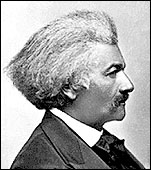 Frederick Douglass
May 1 The "Narrative of the Life of Frederick Douglass" is published. It is a memoir of life growing up as a slave and later a free orator. It serves as a manifesto for the abolitionist movement and is prefaced by two prominent white abolitionists. The publication is popular and positively affects the momentum for abolitionism. Douglass’ former owner attempts to discredit the manifesto but the popularity drowns most criticism out. |
| 1846 |
The Wilmot Proviso, introduced by Democratic representative David Wilmot of Pennsylvania, attempts to ban slavery in territory gained in the Mexican War. The proviso is blocked by southerners, but continues to enflame the debate over slavery. |
| 1847 |
December 3 Frederick Douglass launches his abolitionist and antislavery newspaper, "The North Star". |
| 1849 |
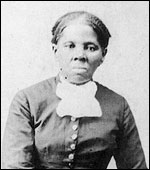 Harriet Tubman
September 17 Harriet Tubman escapes from slavery. She had escaped once before but was forced to turn back after her fellow escapees felt the need to return back to their plantations. She utilizes the Underground Railroad and is relayed across the USA until she makes it to Pennsylvania where she is free. She later becomes one of the most effective and celebrated leaders of the Underground Railroad. |
| 1850 |
November The continuing debate about whether territory gained in the Mexican War should be open to slavery is decided in the Compromise of 1850. California is admitted as a free state, Utah and New Mexico territories are left to be decided by popular sovereignty, and the slave trade in Washington, DC, is prohibited. It also establishes a much stricter fugitive slave law than the original, passed in 1793. |
| 1852 |
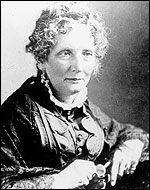 Harriet Beecher Stowe
March 20 Harriet Beecher Stowe's novel, "Uncle Tom's Cabin" is published. It tells the story of a repressed slave on a plantation in America and is sympathetic to the plight of Black people at the time. It becomes one of the most influential works to stir anti-slavery sentiments and is often credited with laying the ground for the American Civil War by making clear distinctions between supporters and opposers of slavery. It is so popular that it finishes the year as the second best seller behind the Bible. |
| 1854 |
May 30 Congress passes the Kansas-Nebraska Act, establishing the territories of Kansas and Nebraska. The legislation repeals the Missouri Compromise of 1820, therefore allowing slavery to be practiced in newly established states. This renewed tensions between anti and pro-slavery factions, especially those that had fought to abolish slavery in all new states. It leads to the founding of the abolitionist Republican Party. It also leads to various violent clashes between the two factions in Kansas which act as a prelude to the Civil War. |
| 1857 |
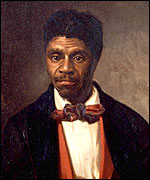 Painting of Dred Scott
March 6 The Dred Scott v. Sandford case rules that Congress does not have the right to ban slavery in states and, furthermore, that slaves are not citizens. Amidst the already fraught relations between northern and southern states, this ruling is incredibly inflammatory and is seen by many as one of the direct causes of the Civil War. |
| 1859 |
October 16-18 John Brown and 21 followers capture the federal arsenal at Harpers Ferry, Virginia (now Western Virginia.), in an attempt to launch a slave revolt. |
| 1861 |
April 12 The Confederacy is founded when the deep South secedes, and the American Civil War begins. The country splits in two, with the south forming the Confederacy and the north the Unionists. Over the course of the war, thousands of slaves escape to freedom in Unionist states and over 180,000 African-Americans end up fighting for the Union Army and Navy. The war does much for the cause of abolitionism as tales of Black war heroes emerge, Black generals are appointed and a general humanization of slaves occurs. |
| 1863 |
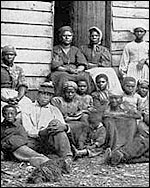 Slaves in Virginia
January 1 President Abraham Lincoln issues the Emancipation Proclamation, which comes into effect on January 1st, 1863. It declares "that all persons held as slaves" within the Confederate states "are, and henceforward shall be free." It transforms the social status of 3 million people overnight and legally recognizes free Black people as their own individuals. It sets the precedent for how the country will run post-Civil War. |
| 1865 |
March 3 Congress establishes the Freedmen's Bureau to protect the rights of newly emancipated Black people. April 9 The American Civil War ends and with it the future of slavery in the USA. However, slaves in Texas are not told until two months later that the war is over and when they are notified, slavery in the USA effectively ends. However, southern states do not let go of slavery and remained determined to restrict the lives of Black people. They pass the "Black Codes" to inhibit the social standing of freed Black people, recognizing their emancipation but severely withholding their ability to live equally in society. April 14 President Abraham Lincoln is assassinated. June 19 Slavery in the United States effectively ends when 250,000 slaves in Texas finally received the news that the Civil War had ended two months earlier. December 6 The 13th Amendment to the Constitution is ratified, abolishing slavery across all states in America. Although this was a legal document, in practice, many Black Americans continue to experience severe discrimination, especially in the south. December 24 The Ku Klux Klan is formed in Tennessee by four white ex-Confederates. From the start, it is a white supremacist organization focused on fighting against the rights of Black people. They use violence as their main tactic, conducting murders of Black people and Black rights supporters, sometimes killing whole families. This first incarnation was outlawed by 1872 but this didn’t stop future revivals of the group in 1915 and 1960. |
| 1865-1866 |
The Black codes are passed by southern states, drastically restricting the rights of newly-freed slaves. |
| 1867 |
July 21 A series of Reconstruction acts are passed, carving the former Confederacy into five military districts and guaranteeing the civil rights of freed slaves. 46 million acres of land are made free to homesteaders and Black Americans are given priority access. |
| 1868 |
July 9 The Fourteenth Amendment to the Constitution is ratified, defining citizenship. Individuals born or naturalized in the United States are American citizens, including those born as slaves. This nullifies the Dred Scott case (1857), which ruled that Black people were not citizens. |
| 1869 |
Howard University's law school becomes the country's first Black law school. |
| 1870 |
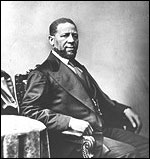 Hiram Revels
February 3 The Fifteenth Amendment to the Constitution is ratified, giving male Black people the right to vote. This is part of a series of moves in society that raise the social standing of ex-slaves and improves their ability to participate. The Howard Law school is also formed around this time, giving Black people the chance to be educated in law, a crucial route to accurate representation in courts. February 25 Hiram Revels of Mississippi is elected the country's first African-American senator. During Reconstruction, sixteen Black people served in Congress and about 600 served in state legislatures. |
| 1874 |
Throughout the year and for those following, southern white militias form such as the "White League" as paramilitary organizations intent on terrorizing Black people and supporters of Black rights. A series of massacres are carried out against all they oppose as well as coups on state governors. It is a consequence of the ending of the Reconstruction which allowed southern states to enforce ways of life on Black people unchecked. |
| 1877 |
Reconstruction ends in the south as the Compromise of 1877 is made, whereby Rutherford Hayes agrees to withdraw federal troops in the south for being elected president. Federal attempts to provide some basic civil rights for African Americans quickly erode and southern states quickly begin to oppress Black people in any legal ways they can. Segregation is enforced in the south. |
| 1879 |
The Black Exodus takes place, in which tens of thousands of African Americans migrated from southern states to Kansas. |
| 1881 |
April 11 Spelman College, the first college for Black women in the U.S., is founded by Sophia B. Packard and Harriet E. Giles. July 4 Booker T. Washington founds the Tuskegee Normal and Industrial Institute in Alabama. The school becomes one of the leading schools of higher learning for African Americans and stresses the practical application of knowledge. In 1896, George Washington Carver begins teaching there as director of the department of agricultural research, gaining an international reputation for his agricultural advances. |
| 1896 |
May 18 The Plessy v. Ferguson case reaches its decision. This landmark U.S. Supreme Court decision holds that racial segregation is constitutional, paving the way for the repressive Jim Crow laws in the South. It determines that the concept of "separate but equal" is legal. John Marshall Harlan was the lone dissenter in the case, stating that the court was “color-blind”. |
| 1905 |
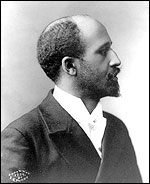 W.E.B. Du Bois
July 11 W.E.B. DuBois founds the Niagara movement, a forerunner to the NAACP. The movement is formed in part as a protest to Booker T. Washington's policy of accommodation to white society. The Niagara movement embraces a more radical approach, calling for immediate equality in all areas of American life. In general, it calls for the equal treatment of all citizens regardless of class, sex, or race. |
| 1909 |
May 31 The National Association for the Advancement of Colored People is founded in New York by prominent Black and white intellectuals and led by W.E.B. Du Bois. For the next half-century, it would serve as the country's most influential African American civil rights organization, dedicated to political equality and social justice. In 1910, the association's journal, "The Crisis", was launched. Among its well-known leaders were James Weldon Johnson, Ella Baker, Moorfield Storey, Walter White, Roy Wilkins, Benjamin Hooks, Myrlie Evers-Williams, Julian Bond, and Kwesi Mfume. |
| 1914 |
July 15 Marcus Garvey establishes the Universal Negro Improvement Association, an influential Black nationalist organization "to promote the spirit of race pride" and create a sense of worldwide unity among Black people. |
| 1915 |
February 8 "The Birth of a Nation" is released in cinemas across the country. The film, directed by D. W. Griffith, depicts the assassination of Lincoln as a positive event and proceeds to glorify the actions of the original Klu Klux Klan. It also depicts Black people as being stupid and sexually aggressive toward women. It is instantly highly controversial and outrages those supporters of Black rights. The NAACP organized protests outside cinemas that show the film. |
| 1917 |
November 5 The Buchanan v. Warley Supreme Court case rules that the ban on selling properties to Black people in white neighborhoods is unconstitutional as a violation of the 14th Amendment. This was still only applicable to public housing, private properties could still be subject to discrimination. Nonetheless, this was important as it gave Black people a legal right to own property wherever. Property ownership is key to building personal wealth security. |
| 1918 |
May 19 Mary Turner, a pregnant Black woman, is murdered via lynching by a white mob after protesting against the earlier lynching of her husband. Her unborn child is also killed by the mob. It leads to a brief outcry but nothing criminal comes from the incident. The NAACP uses it as an example to demonstrate the persecution that Black people face. In general, the killing is just one of many similar incidents that occur from 1880-1930 in what is known as the lynching era. |
| 1920s |
The Harlem Renaissance flourishes in the 1920s and 1930s. This literary, artistic, and intellectual movement fosters a new Black cultural identity. The movement was characterized by racial pride and an unashamed expression of Black cultural outputs. The Great Migration from the southern state aided the renaissance as many moved into urban areas like Harlem. |
| 1931 |
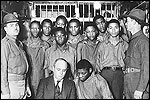 The Scottsboro Boys
March 25 Nine Black youths are indicted in Scottsboro, Alabama, on charges of having raped two white women. Although the evidence was slim, the southern jury sentenced them to death. The Supreme Court overturns their convictions twice; each time Alabama retries them, finding them guilty. In a third trial, four of the Scottsboro boys are freed, but five are sentenced to long prison terms. |
| year |
September 1 World War II begins. Black troops fight shoulder to shoulder with white troops as a very visceral example of a non-segregated society. Black men laid down their lives in defense of the western world which was viewed positively in America. In general, the war made the American public more sympathetic to the cause of Black rights after stories of heroism and sacrifice become famous. |
| year |
February 29 Hattie McDaniel becomes the first African American to win an Academy Award as Best Supporting Actress in "Gone With The Wind". She is part of an emerging set of Black celebrities in the USA, including the highly successful sprinter Jesse Owens, who gain popular support for the cause of racial equality. |
| 1947 |
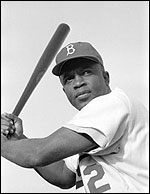 Jackie Robinson
Jackie Robinson breaks Major League Baseball's color barrier when he is signed to the Brooklyn Dodgers by Branch Rickey. |
| 1948 |
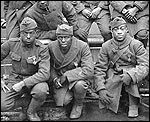 WWI Black Soldiers
Although African Americans had participated in every major U.S. war, it was not until after World War II that President Harry S. Truman issues an executive order integrating the U.S. armed forces. It is one of the earliest and highest-profile actions of desegregation in America and was a sign of a slowly turning tide in favor of Black rights at higher political levels. |
| 1953 |
June Malcolm X becomes a minister of the Nation of Islam. Over the next several years his influence increases until he is one of the two most powerful members of the Black Muslims (the other was its leader, Elijah Muhammad). A Black nationalist and separatist movement, the Nation of Islam contends that only Black people can resolve the problems of Black people. |
| 1954 |
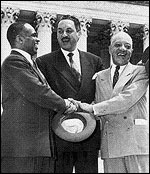 Pictured from left to right:
May 17 Brown v. Board of Education of Topeka, Kansas declares that the "separate but equal" laws are unconstitutional and discriminatory, therefore ending racial segregation in schools as a legal precedent. This finally overturns the long-standing Plessy v. Ferguson case which first installed the law and enshrined segregation in the societies of southern states. It is a landmark ruling for the advancement of Black educational rights. |
| 1955 |
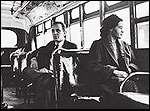 Rosa Parks
August 25 Emmett Till, a Black teenage boy, is brutally murdered by two white men for allegedly whistling at a white woman. He is beaten so badly that he is unidentifiable by his own mother save for some distinctive jewelry. The murder becomes high profile as a demonstration of the outrageous violence used by white supremacists. Till’s mother also demands an open coffin so that pictures of her son’s face could be taken by the press and spread across the globe. Two white men charged with the crime are acquitted by an all-white jury. They later boast about committing the murder. The public outrage generated by the case helps spur the civil rights movement. December 1 Rosa Parks refuses to give up her seat at the front of a bus to a white passenger. At the time, buses were segregated and Black people were required to give up their seats. Parks is arrested and in response, Montgomery's Black community launches a successful year-long bus boycott. Montgomery's buses are desegregated on December 21st, 1956, in a court case actually related to Claudette Colvin, another Black woman who refused to give up her seat nine months before Parks. |
| 1957 |
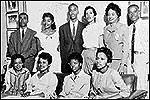 The Little Rock Nine
February 14 The Southern Christian Leadership Conference (SCLC), a civil rights group, is established by Martin Luther King, Charles K. Steele, and Fred L. Shuttlesworth. King is elected the group's president, starting his journey into public prominence as one of the most influential leaders in the Civil Rights Movement. His group stresses that non-violent direct action is the best way to advance the cause of Black people. September 24 Nine Black students are blocked from entering Little Rock Central High School, Little Rock on the orders of Governor Orval Faubus. Federal troops and the National Guard are called by President Eisenhower to intervene on behalf of the students, who become known as the "Little Rock Nine". They are escorted into class amid furious protests from white parents. Despite a year of violent threats, several of the Little Rock Nine manage to graduate from Central High. |
| 1960 |
February 1 Four Black students in Greensboro, North Carolina, begin a sit-in at a segregated Woolworth's lunch counter. Over the course of three months, the groups swelled to over 1,000 protestors who joined the sit-ins. White counter-protestors tried to intimidate them but to no avail. Six months later the "Greensboro Four" are served lunch at the same Woolworth's counter. The event triggers many similar nonviolent protests throughout the South. April 15 The Student Nonviolent Coordinating Committee (SNCC) is founded, providing young Black people with a place in the civil rights movement. It is an official channel through which students and young people can contribute to the civil rights movement, becoming crucial in organizing nationwide, coordinated protests. They also look to unite Black and white people that believe in the same cause. |
| 1961 |
May 4 Over the spring and summer, student volunteers begin taking bus trips through the South to test out new laws that prohibit segregation in interstate travel facilities, which include bus and railway stations. Several of the groups of "freedom riders", as they are called, are attacked by angry mobs along the way. The program, sponsored by The Congress of Racial Equality (CORE) and the Student Nonviolent Coordinating Committee (SNCC), involves more than 1,000 volunteers, Black and White. It turns into a nationwide movement with MLK involved, and eventually, desegregation is enforced by the government. |
| 1962 |
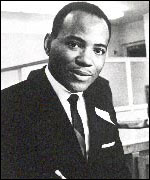 James Meredith
October 1 James Meredith becomes the first Black student to enroll at the University of Mississippi. He is at first denied by the university but they are overruled by the Supreme Court. Meredith is admitted and a riot ensues fueled by white supremacists. Two people are killed and President Kennedy sends 5,000 federal troops after rioting breaks out. Meredith enrolls the next day. This also presents one of many examples of the Kennedy brothers using their state powers to protect and actively advance the rights of Black people. It is a marked contrast to previous governments. |
| 1963 |
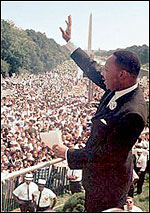 Martin Luther King, Jr.
April 16 Martin Luther King is arrested and jailed during anti-segregation protests in Birmingham, Alabama. He writes "Letter from Birmingham Jail," which advocated nonviolent civil disobedience. August 28 The March on Washington for Jobs and Freedom is attended by about 250,000 people, the largest demonstration ever seen in the nation's capital. Martin Luther King delivers his famous "I Have a Dream" speech. The march builds momentum for civil rights legislation and still stands as perhaps the most renowned event in the entire history of the civil rights movement and American history in general. September 15 Four young Black girls attending Sunday school are killed when a bomb explodes at the Sixteenth Street Baptist Church, a popular location for civil rights meetings. Riots erupt in Birmingham, leading to the deaths of two more Black youths. The resulting Alabama Project, established by James Bevel and Diane Nash, lays the groundwork for the Selma Voting Rights Movement. Despite Governor George Wallace physically blocking their way, Vivian Malone and James Hood register for classes at the University of Alabama. |
| 1964 |
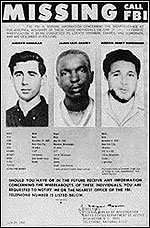 FBI photographs of Goodman,
Sidney Poitier wins the Best Actor Oscar for his role in "Lilies of the Field". He is the first African American to win the award. June 21 The bodies of three civil-rights workers (Andrew Goodman, James Earl Chaney, and Michael Schwerner) are found. Murdered by the KKK and Neshoba County Police officers, James E. Chaney, Andrew Goodman, and Michael Schwerner had been working to register Black voters in Mississippi. The resulting case causes national outrage and galvanizes support for the upcoming Civil Rights Act. July 2 President Johnson signs the 1964 Civil Rights Act, the most sweeping civil rights legislation since Reconstruction. It prohibits discrimination of all kinds based on race, color, religion, or national origin. Months earlier President Kennedy is assassinated and Johnson decides to pursue Kennedy’s election manifesto, offering continued support for the civil rights movement. December 10 Martin Luther King receives the Nobel Peace Prize and is the youngest person to be recognized. This legitimizes him on a global stage and presents the civil rights movement as a just cause. |
| 1965 |
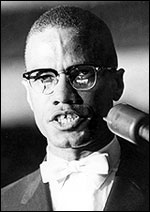 Malcolm X
February 21 Malcolm X, a Black nationalist and founder of the Organization of Afro-American Unity, is assassinated. Malcolm X was a major leader in the civil rights movement and emerged as a semi-opposing force to MLK in that he supported more proactive and at times provocative methods of protest. He was a vocal proponent of the spread of Islam within the Black community. March 7 Known as Bloody Sunday, state troopers violently attack peaceful demonstrators led by Rev. Martin Luther King, Jr., as they try to cross the Pettus Bridge in Selma, Alabama. Fifty marchers are hospitalized after police use tear gas, whips, and clubs against them. The march is considered the catalyst for pushing through the voting rights act five months later. It is the major event of the Selma Voting Rights cause. August 6 Congress passes the Voting Rights Act of 1965, making it easier for Black people in the south to register to vote. Convoluted and discriminatory processes such as literacy tests, poll taxes, and other such requirements that were specifically introduced to reduce the number of Black voters are made illegal. It is a landmark act as it enables a huge part of the population to have a say in politics. August 11-16 In six days of rioting in Watts, a predominantly-Black portion of Los Angeles, 35 people are killed and 883 injured. |
| 1966 |
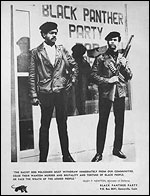
October The Black Panther Party is founded by Huey Newton and Bobby Seale in California. The Black Panthers are a proactive organization seeking to protect Black people on the streets, especially from the police in what they called the "Patrol the Pigs" campaign. They were viewed as more militant than other groups and sometimes carried weapons as protection. They were communists in their ideology and were viewed as a threat by the government. |
| 1967 |
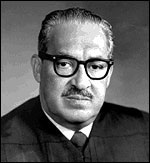 Thurgood Marshall
April 19 Stokely Carmichael, a leader of the Student Nonviolent Coordinating Committee (SNCC), coins the phrase "Black power" in a speech in Seattle. June 12 The Supreme Court rules in Loving v. Virginia that prohibiting interracial marriage is unconstitutional. 16 states still have anti-miscegenation laws and are forced to revise them. June 13 President Johnson appoints Thurgood Marshall to the Supreme Court. He becomes the first Black Supreme Court Justice. Previously, he was a leading lawyer for the NAACP which makes his appointment all the more of a landmark. Having Black judges in court is seen as a crucial step in making the judiciary system more equitable. His practice and decision-making were drawn from lived experiences of discrimination. July 23 The Detroit riots erupt after a police raid on a majority Black club. The riot lasts for days and sees mass violence, looting property damage, and clashes with police. It surpasses the previous Detroit riot for its scale and damage and is symptomatic of the poor race relations between Black citizens and the police force. It was part of what was known as the "Long Hot Summer of 1967". |
| 1968 |
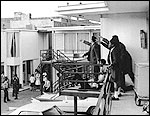 Eyewitnesses to the
April 4 Martin Luther King, Jr., is assassinated in Memphis, Tennessee. He is shot whilst on a motel balcony and James Earl Ray is convicted of the shooting. Robert Kennedy stands firm with the Black community and is credited with handling the situation well in terms of quelling retribution acts. Conspiracy and confusion surround the shooting including accusations of government involvement. April 11 President Johnson signs the Civil Rights Act of 1968, prohibiting discrimination in the sale, rental, and financing of housing. This was a landmark bill that finally removed legal barriers to Black people owning their own property. In practice, it was still often an arduous process for Black people to move into predominantly white neighborhoods due to racism. The act also criminalized violence inflicted on grounds of race. November 30 Shirley Chisholm becomes the first Black female U.S. Representative. A Democrat from New York, she was elected in November and served from 1969 to 1983. |
| 1972 |
November 16 The infamous Tuskegee Syphilis experiment ends. The experiment, begun in 1932, saw the U.S. Public Health Service experiment on 399 Black men in the late stages of syphilis. The scientists wanted to observe what happened if left untreated but still continued the experiment once a cure had been found. The scientists operated on racist assumptions that Black people were more susceptible to disease and that they would not want to be cured. |
| 1978 |
June 28 The Supreme Court case, Regents of the University of California v. Bakke upheld the constitutionality of affirmative action but imposed limitations on it to ensure that providing greater opportunities for minorities did not come at the expense of the rights of the majority |
| 1983 |
August 30 Guion Bluford Jr. becomes the first African-American in space. He took off from Kennedy Space Center in Florida on the space shuttle Challenger. He is recruited as part of a specific initiative to include more women and minority groups in the space program. Bluford serves on three further Challenger space missions and is inducted into the International Space Hall of Fame in 1997. |
| 1992 |
April 29 The first race riots in decades erupt in south-central Los Angeles after a jury acquits four white police officers for the videotaped beating of African American man Rodney King. King was pulled over after a DUI chase and was severely beaten by four officers whilst 17 others watched on without intervening. The jury found the officers not guilty and riots ensued. Eventually, a grand jury sentenced two of the officers to prison time. September 12 Mae Carol Jemison goes into orbit aboard Space Shuttle Endeavour, becoming the first African American woman in space. A month later, Carol Brown becomes the first African American woman to be elected to the U.S. Senate. Around this period, a variety of firsts for Black people in America begin to happen as a sign of the slowly changing attitudes towards minorities in the country. |
| 2001 |
January 20 Colin Powell becomes the first African American U.S. Secretary of State. It is one of the many firsts in a long line that eventually lead up to Barack Obama becoming the first African American President. Powell was the son of Jamaican immigrants and had served in the U.S. Army for 35 years. He later endorsed Hilary Clinton in 2016 over Donald Trump who he saw as being wholly unfit to run for office. Condoleezza Rice becomes the first African American woman to do this in 2005. |
| 2002 |
March 24 Halle Berry becomes the first African American woman to win the Best Actress Oscar. She takes home the statue for her role in "Monster's Ball". Denzel Washington, the star of "Training Day", earns the Best Actor award, making it the first year that African Americans win both the best actor and actress Oscars. |
| 2003 |
June 23 In Grutter v. Bollinger, the most important affirmative action decision since the 1978 Bakke case, the Supreme Court (5–4) upholds the University of Michigan Law School's policy, ruling that race can be one of many factors considered by colleges when selecting their students because it furthers "a compelling interest in obtaining the educational benefits that flow from a diverse student body." |
| 2005 |
Condoleezza Rice becomes the first Black female U.S. Secretary of State. |
| 2006 |
December 4 In Parents v. Seattle and Meredith v. Jefferson, affirmative action suffers a setback when a bitterly divided court ruled 5-4 that programs in Seattle and Louisville, which tried to maintain diversity in schools by considering race when assigning students to schools, are unconstitutional. |
| 2008 |
November 4 Senator Barack Obama, a Democrat from Chicago, is elected the first African American president of the United States, defeating Republican candidate, Senator John McCain. Throughout his campaign, he is plagued by entirely unfounded claims that he was born in Kenya instead of Hawaii, therefore making him illegitimate as a presidential candidate. Donald Trump is one of the main proponents of the conspiracy theory and it is seen as an indication of the remaining racist attitudes toward Black people. |
| 2009 |
January 20 Barack Obama is sworn in as the first African American president and the country's 44th president. February 2 The U.S. Senate confirms, with a vote of 75 to 21, Eric H. Holder, Jr., as Attorney General of the United States. Holder is the first African American to serve as Attorney General. |
| 2012 |
February 26 Trayvon Martin, a 17-year-old Black boy, is shot by George Zimmerman, a 28-year-old mixed-race man in Florida. Zimmerman is acquitted of murder charges but the public reaction sees outrage and protests across the nation. The perceived injustice at the lack of criminal charges sees the phrase "Black Lives Matter" used on social media as a widespread slogan for the first time. The killing itself, along with further killings of Black people, and the social media reaction give rise to the Black Lives Matter movement. |
| 2014 |
August 9 Michael Brown, an unarmed 18-year-old Black man was shot and killed in Ferguson, Missouri by police officer Darren Wilson. On November 24, the grand jury decision not to indict Wilson was announced, sparking mass protests in Ferguson and cities across the U.S., including Chicago, Los Angeles, New York, and Boston. It gives rise to the "Hands Up, Don’t Shoot" phrase and also further galvanizes those fighting racial injustice to take action. July 17 The protests from Michael Brown’s case continue to spread throughout the country after a Staten Island grand jury decided in December not to indict Daniel Pantaleo, the police officer involved in the death of Eric Garner. Garner died after being placed in a chokehold by Pantaleo. The chokehold is a prohibited move in police conduct but still, the officer escapes prosecution. |
| 2015 |
The 114th Congress includes 46 Black members in the House of Representatives and two in the Senate. Michael Bruce Curry becomes the first African-American Presiding Bishop of the Episcopal Church. June 17 Nine Black worshippers at a church in Charleston, South Carolina are murdered by Dylan Roof, a self-proclaimed white supremacist. It led to a reassessment of Confederate insignia after Roof was linked to it. As such, Confederate flags were removed from state buildings in South Carolina as well as statues and memorials. |
| 2016 |
Carla Hayden was confirmed as the first female African American head of the Library of Congress. August 9 Simone Biles became the first African American woman to bring home four Olympic gold medals in women’s gymnastics at a single game (as well as a bronze at the 2016 Rio Olympics). Also, in Rio de Janeiro, Simone Manuel was the first African American woman to win an individual event in Olympic swimming. |
| 2020 |
Across 2020, a series of police killings of unarmed Black people occurs. Breonna Taylor is shot on March 13th after police entered her apartment, George Floyd was killed via improper restraint on May 25th, Rayshard Brooks was shot on June 23rd, and Jacob Blake was shot in his own car on August 23rd. All of these incidents incite vigorous reactions amongst the public, especially after many of the officers involved in the killings are not charged in court. George Floyd’s murder changes this, however, when the public demonstrates in unprecedented numbers and scope across the nation. Some demonstrations turn into week-long riots as the anger at a lack of accountability in the police does not go away. Eventually, Derek Chauvin, the officer who killed Floyd, is sentenced to 21 years for murder. |
| 2021 |
January 20 Kamala Harris is sworn in as the first-ever African American, Asian American, and female Vice President. She is the second person of color to hold the position after the Native American Charles Curtis, who served under Herbert Hoover. She became the first woman to hold presidential powers when President Biden underwent a medical procedure in November 2021. |
| 2022 |
May 14 10 Black people are murdered in a mass shooting in Buffalo, New York, by 18-year-old Payton Gordon, a white male. Gordon drove over 124 miles to the location to carry out the shooting and had previously scouted the area beforehand. Gordon had written a manifesto, proclaiming his beliefs in neo-Nazi and white supremacist views. He pleads guilty to all charges. |
What Are Important Dates in Black History?
The timeline above illustrates a turbulent, tragic, violent, and often inspiring story of Black history.
The start of the Atlantic slave trade over 400 years ago was the root of a sprawling, traumatic experience for Black people in America that has lasted to the present day. Key figures have defined major moments, but throughout it all, it has been regular people who have struggled but also prevailed.
From outright oppression in the 1600s to hard-won freedoms in the 1800s, a regression into violent hatred in the early 1900s, and a slow struggle for civil rights from the 1950s onwards, the course of Black history has gradually been transferred from the hands of white people to Black individuals who are leading the way in holding society to account.
Today, persecution against ethnic minorities continues and injustices remain a constant, but there are figures within these communities — as there always have been — that are shining a light on inequity and waving the flag for Black excellence.
Now that you have read a comprehensive history of Black people in the USA, why not take a deep dive into the hugely important civil rights movement of the 1960s?







